The Neck Cloth Timeline
The 1740s and 1750s (ish)
The plan for these pages is to work our way steadily through the decades relating the various methods that come up in the paintings. Having reached the 40s and 50s now, our collection of paintings and portraits tend to contain mainly 3 of the Methods. These are: the ‘Tucked Method’, ‘Through the Lacing Method’ and the ‘Loose Method’ – with the last two being easily the hands-down winners. Other methods that do arise are: the ‘Twist Method’ and the ‘Tied Method’.
The first im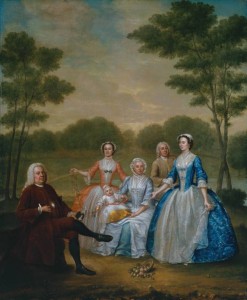 age is of ‘The Betts Family’ and was painted by Stephen Slaughter in c.1746 (please look left). All 3 ladies are wearing cloths and all 3 ladies wear them using the ‘Through the Lacing Method’. We love it when you can just see image after image showing such similarities, it helps us get a good grip on what was not just fashionable garments but how they were worn and the look they were all trying to emulate.
age is of ‘The Betts Family’ and was painted by Stephen Slaughter in c.1746 (please look left). All 3 ladies are wearing cloths and all 3 ladies wear them using the ‘Through the Lacing Method’. We love it when you can just see image after image showing such similarities, it helps us get a good grip on what was not just fashionable garments but how they were worn and the look they were all trying to emulate.

Then there is Mary Edwards, who apparently had this painting commissioned in 1742 by Hogarth to prove her critics wrong (supposedly they were saying she wasn’t very fashionable). She wears a full cloth through what we can only assume is a ‘Buckle for the Stays’. We’ve never actually seen one of these Buckles so the clarity afforded in this painting is intriguing – this must be what they looked like. However her painting shows some other quite good details (good old Hogarth) for example her gown is a closed gown which is unusual, her robings look to be double robed, her sack is loose and untrained at the back, she appears to be wearing a chateleine (which we were under the impression was very out of fashion for this period) and a heavy necklace with a cross which is also seemingly rare (again ummm….in our understanding) and her sleeves are a massive example of the early baggy sleeve. But most importantly for this page she wears her cloth using the ‘Through the Lacing Method’.
Persisting in our steady move through the 40’s we now get to ‘The Rogers family’ by F.Hayman (see left) and dated 1748-50. Both ladies wear cloths – ‘Through the Lacing’ Method again, but their sacks take on a much more neater and more trained look than the previous painting. These two paintings could be a good example of the progressio n of sacks for the 1740’s as we are looking at a good 6 years between the Mary Edward’s portrait and these two ladies. See how much more contained their sleeves look to previous portrait! It’s nice to be able to show a growth in fashion and pattern cutting style, but 18th c fashion is never that clear cut and there are other portraits that don’t witness to this change of pattern cutting so, although they show the good, clear difference, perhaps we ought not to get too excited . For example, the very next image manages to innocently trash thi
n of sacks for the 1740’s as we are looking at a good 6 years between the Mary Edward’s portrait and these two ladies. See how much more contained their sleeves look to previous portrait! It’s nice to be able to show a growth in fashion and pattern cutting style, but 18th c fashion is never that clear cut and there are other portraits that don’t witness to this change of pattern cutting so, although they show the good, clear difference, perhaps we ought not to get too excited . For example, the very next image manages to innocently trash thi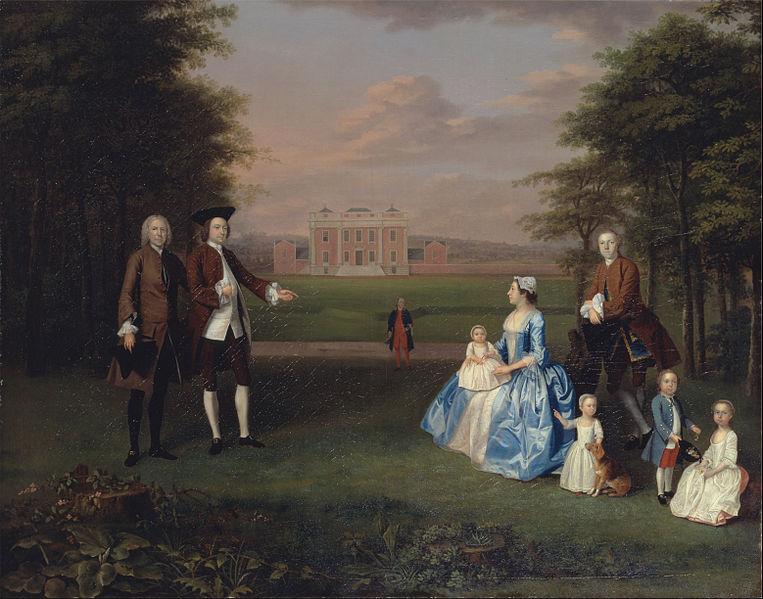 s idea….
s idea….
We also have the family painting of Robert Gwillym and co, painted by Devis in 1749. We’ve left it fairly large otherwise our poor lady here and her neck cloth will fade out from all distinction. This is another example of a lady wearing her neck cloth using the ‘Through the Lacing Method’. She also wears a very fine Apron whic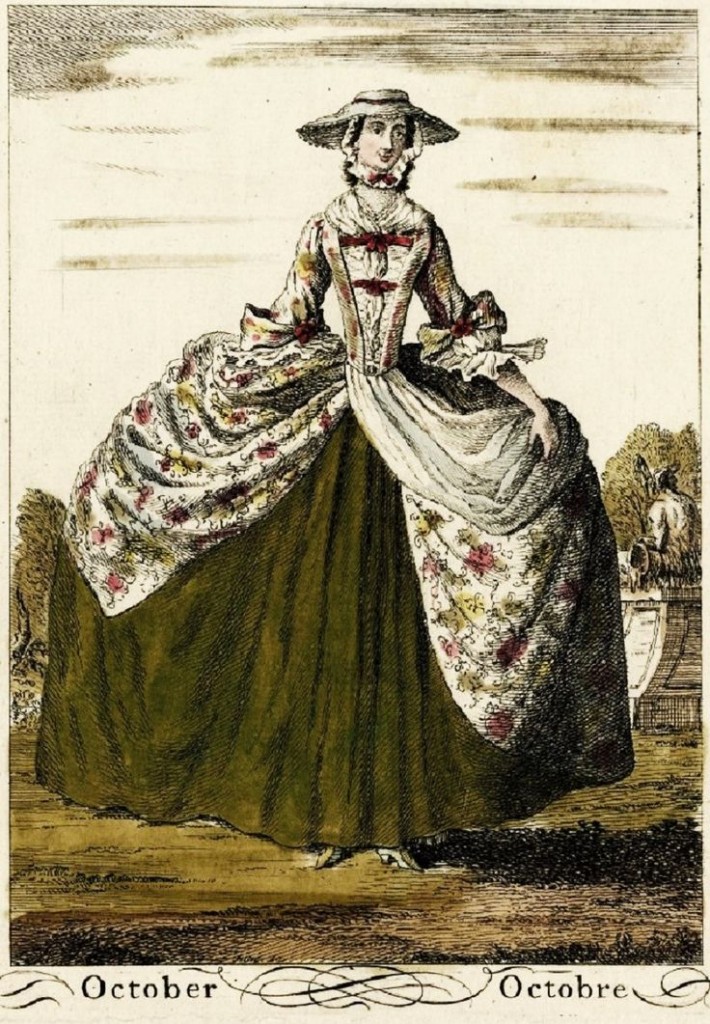 h really comes into it’s own during the 50’s. Here though you can see the beginnings of it and also the speed at which fashion moved throughout the 18th c. Small things could flit in and out, but generally, fashion seemed to have moved in a very slow wave formation and could take decades to eventually pass on by, or even take root.
h really comes into it’s own during the 50’s. Here though you can see the beginnings of it and also the speed at which fashion moved throughout the 18th c. Small things could flit in and out, but generally, fashion seemed to have moved in a very slow wave formation and could take decades to eventually pass on by, or even take root.
We also have an image from a series of paintings or rather engravings entitled ‘Months by J.June and published by Voisin’. The engraving is of ‘October’ and dated 1749. It features a ‘Through the Lacing Method’. ‘March’, ‘July’ and ‘April’ also all wear their Neck Cloths tucked ‘Through the Lacing Method’. ‘June’, ‘May’ and ‘August’ wear no cloths at all – interesting isn’t it! Here’s a picture of our ‘October’ lady…. Oh, and the rest of the months are covered up with capes.
Bare Necked…
Before we move into the 50’s, we also have a rather significant collection of images of ladies NOT wearing neck cloths at all. There are several things we’d like to say about this before we begin. We believe this constant fashion of not wearing Neck cloths has a fair few factors involved in it. Now please understand, we are not saying that any one of these factors is the all-conclusive answer, but we think that they are a possible, realistic breakdown of what could be involved in the decision to wear or not wear a Neck Cloth.
Personal Taste:
First off, it’s needless to say that you cannot account for personal taste. If there are humans involved then you’ve already muddied the water, so to speak. The following arguments are argued on the basis that this essential fact remains running alongside them.
Undress:
The next factor we’d like to argue is the use of Neck Cloths in Undress.
3 of the 4 above images all contain Family Conversation Pieces – ie doing un-Formal things and the natural dress to match that would be ‘Undress’. For example, in the painting of Robert Gwillym and his family (just above), the group are enjoying being outside in their garden (for want of a better word) and seated in front of their stately home. Though none of the gentleman are wearing Frocks (the sporting jacket of the time) they are neither in more court-like fashions as would be more likely the case if they were doing a formal portrait. In the painting of The Rogers Family (2 paintings above) the group are pretending to be at fishing, and he is indeed in a frock, holding up his prize to the artist. We’d like to suggest that if the occasion required ‘Undress’ then it was far more likely that a Neck Cloth was worn.
Age:
The next Factor we’d like to put forward is Age.
One of the observations that comes up frequently from studying the paintings – particularly in the Group/Family paintings where you get the different generations sitting side by side – is this fairly regular habit of the older ladies wearing cloths with the younger ones in Ruffles. ‘Samuel Richardson and Family’ by Hayman 1740-41 is a good example of this, as is ‘The Gascoigne Family‘ by Hayman, dated c.1740 (see below). We have also done studies on these particular two paintings in a separate research page, so please feel free to get side-tracked and click on the links here if you like. But this fashion for the younger ladies being less likely to wear a neck cloth could be attributed to the idea that cloths were already becoming more outdated. It might be a mistake to come to that conclusion though. We think it’s far more likely that the practical 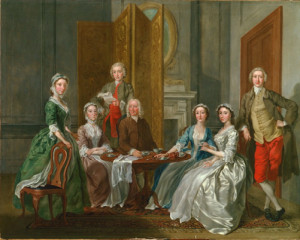 aspects of wearing a cloth vs having a more youthful figure is perhaps a more realistic reason behind this. It is easy to assume declarations along the lines of it being a younger-social status (like some say the cap can be) or some sign of virginity or pre-marriage symbol that hinted of their availability and marriageability but there are paintings of married women who are still youthful and are also bare necked. Possibly it has rather more to do with (not to put it too delicately) the fact that the younger ladies, married or not, have the nicer, fresher figures, more petit bosoms and slenderer necks than the older women who might be more inclined to cover up. It seems the same with the younger ladies wearing smaller caps vs the tying round of the lappets under the chins which the older generation seem to adopt. Seeing more of the younger lady’s body seems a recurring theme and though it is possible that it could be a fashion purely for the 1740’s, there is a similar tale in the 60s (Hodge Family by Dance – c.1766, Zoffany’s Young Family 1767-69) and into the 70’s (Unnamed Family by Wheatley – 1775) and into the 80’s (Fourdrinier Family attributed to J.Downham – 1786). It seems that it is not just the 40’s where the younger generation being bare-necked while their older members of the family where neck cloths. It cannot be that it was perpetually going out of fashion.
aspects of wearing a cloth vs having a more youthful figure is perhaps a more realistic reason behind this. It is easy to assume declarations along the lines of it being a younger-social status (like some say the cap can be) or some sign of virginity or pre-marriage symbol that hinted of their availability and marriageability but there are paintings of married women who are still youthful and are also bare necked. Possibly it has rather more to do with (not to put it too delicately) the fact that the younger ladies, married or not, have the nicer, fresher figures, more petit bosoms and slenderer necks than the older women who might be more inclined to cover up. It seems the same with the younger ladies wearing smaller caps vs the tying round of the lappets under the chins which the older generation seem to adopt. Seeing more of the younger lady’s body seems a recurring theme and though it is possible that it could be a fashion purely for the 1740’s, there is a similar tale in the 60s (Hodge Family by Dance – c.1766, Zoffany’s Young Family 1767-69) and into the 70’s (Unnamed Family by Wheatley – 1775) and into the 80’s (Fourdrinier Family attributed to J.Downham – 1786). It seems that it is not just the 40’s where the younger generation being bare-necked while their older members of the family where neck cloths. It cannot be that it was perpetually going out of fashion.
Artistic License:
The above possibility also brings us to another one: it could be that the particular use of the younger ladies in group paintings being unclothed was to distinguish them. It’s hard not to notice the generic family painting similarities – face seem incredibly similar from one painting to another, and it’s possible that they were less meant to be ‘warts and all’ style paintings compared to general art for the walls. What we mean is we wonder how many of the sitters back then expected to be able to feel like they were looking in a mirror when they looked at the finished painting. It might be that hair colour, perhaps a favourite piece of jewelry , position in the painting was enough to distinguish who was who. With this idea in mind it’s easy to understand why the younger generation – people like daughters and nieces – were painted with less neck cloths and freer faces to set them apart in their role in the painting and family.
Season:
A Possible Other Alternative Factor is ‘Season’:
It’s interesting that in J.June’s ‘Months’ Series of engravings, it was half of the the summer months (and late spring and early Autumn) that the ladies were bare necked. NONE of the winter months held ladies without neck cloths or capes (we possibly coudn’t see the neck cloth beneath the cape but in the sense of the ‘neck being covered’; it was covered! If you’d like to see all of these images please click here (except page isn’t yet created but you can certainly google ‘J.June Months – 1749).
Now, back to our Listings:
The next image is of the lovely L.Ebberton, and here we leave the late 40’s and move into the 50s where we start with this painting. Painted in a pastoral style here with her relaxed ribbons and basket of flowers,  L.Ebberton, by George Knapton, is seated showing what we call the ‘Shadow Mark’ from her Stays and a very full, kind of Organza looking Apron. The portrait is dated c.1750s. Her dress is beautifully painted and Knapton really captures this lightening of silks and the airy and gentle floral look that was growing in strength from about this period. According to Buck it’s the 40’s and 50’s where these light ground and floral silks really begin to come into fashion. (see Dress in 18th Century England – A Buck) and it’s good to have such a clear example of this growing trend. L. Ebberton wears her neck cloth using the ‘Through the Lacing Method’. It also has a lovely example of the ruffles coming from the shift and with lace attached at the ends. It’s a vague study of ours but we’re also just trying to note what kind of jewelry people wear and her’s is quite an unusual necklace. However, the sleeves are still quite bulky and broad with the large grown-on cuff be
L.Ebberton, by George Knapton, is seated showing what we call the ‘Shadow Mark’ from her Stays and a very full, kind of Organza looking Apron. The portrait is dated c.1750s. Her dress is beautifully painted and Knapton really captures this lightening of silks and the airy and gentle floral look that was growing in strength from about this period. According to Buck it’s the 40’s and 50’s where these light ground and floral silks really begin to come into fashion. (see Dress in 18th Century England – A Buck) and it’s good to have such a clear example of this growing trend. L. Ebberton wears her neck cloth using the ‘Through the Lacing Method’. It also has a lovely example of the ruffles coming from the shift and with lace attached at the ends. It’s a vague study of ours but we’re also just trying to note what kind of jewelry people wear and her’s is quite an unusual necklace. However, the sleeves are still quite bulky and broad with the large grown-on cuff be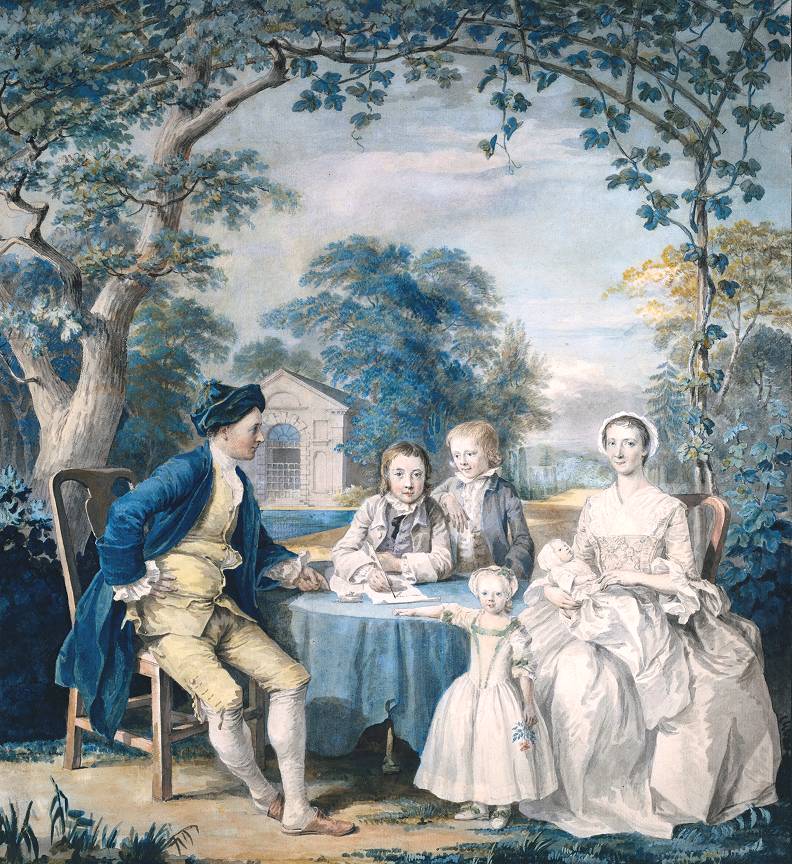 ing a design feature.
ing a design feature.
We seem to be only showing ‘Through the Lacing Methods’ here but it is not purposeful. Travelling in just date order through the images that show clear recordings of the neck cloth, this is the first image that bears a different technique. In the next image, dated 1754 is the first time that the ‘Tucked-in Method’ has cropped up. It has been entitled ‘Family Group’ and just simply ‘British School’ by the Tate. It’s an interesting image, but for the use of this page here, we are just interested in the lady and who is wearing her neck cloth tucked into her stomacher. Her stomacher sits very widely in proportion to her torso, it is also decorated with furbelow trim. She seems to wear her hair natural but neatly tidied away into a cap with a frill. She has tiered ruffles at her sleeves and plain, all-round-length engageants/ruffles beneath them. Her sleeves also look trim and not too baggy. She wears an apron and her husband, if we zoom in on the painting and look at the details, wears his yellow breeches open at the knee and with his stockings loose. It’s an interesting way to be chosen to be painting. Perhaps it is a form of Undress or is making a statement about something.
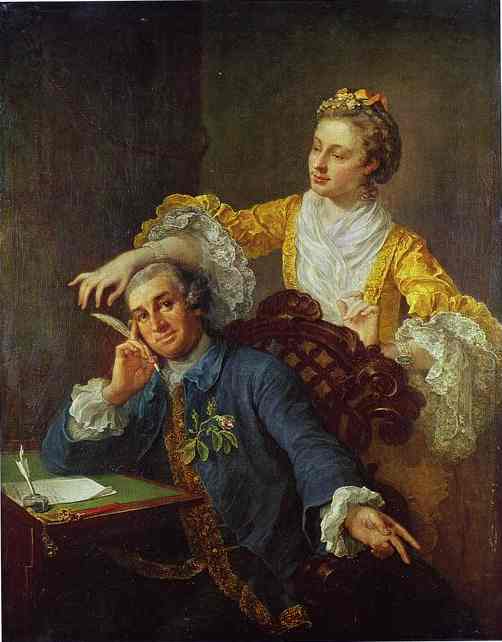 There is also the painting for Mr and Mrs Garrick by Hogarth. Here the thespian’s wife leans playfully over her husband’s shoulder to snatch at his quill but what really interests us for this research page, is the fact that she wears her neck cloth in an amalgamation somewhere between the Twist Method and the Tucked Method. If it’s an actual Twist Method then it will be the first one from our images in England. However, the twisting is very loose and more like it’s been manipulated to fill out more of the neck space rather than being the definite tighter twists that the French ladies wore. She also has small single robings with neat and trim furbelows mounted on them and the gap between the Robings is quite wide. She also has lacey flounces spilling out from beneath her Ruffled Cuffs.
There is also the painting for Mr and Mrs Garrick by Hogarth. Here the thespian’s wife leans playfully over her husband’s shoulder to snatch at his quill but what really interests us for this research page, is the fact that she wears her neck cloth in an amalgamation somewhere between the Twist Method and the Tucked Method. If it’s an actual Twist Method then it will be the first one from our images in England. However, the twisting is very loose and more like it’s been manipulated to fill out more of the neck space rather than being the definite tighter twists that the French ladies wore. She also has small single robings with neat and trim furbelows mounted on them and the gap between the Robings is quite wide. She also has lacey flounces spilling out from beneath her Ruffled Cuffs.
Next is an amazingly clear, all most real-to-life painting by Liotard. It’s funny how some artists just shine out and Liotard is definitely one of them. Painted in 1755, this painting is of Mdm Jean-Louise Maisonnet and features an interesting way of wearing the neck cloth. Again, this is a french portrait where the fashions were slightly different but it’s worth listing, the French were, after all, leaders of fashion in the 18th c. See how she wears it pulled taut over the top half of her bodice and tucking it into one of the lacings details further down. The neck cloth has a scalloped edge worked in White work and seems to be of a smooth, fine quality of linen/cotton but not so fine as to be see-through. Her cap is incredible and is a fantastic example of both how the lappets could be pinned under the chin but also how the ribbon was tied on – at an angle here and hinting of a practical nature that helps hold the cap on. Just for more details, her robings are doubled but are of a wide nature – the top robing has to be about 4″ minimum and the seen bit of the second a good 3/4 of an inch. Her sack appears to bellow out behind her but her sleeve is much more contained than others you can see of this period. We’re still classing this as the Through the Lacing method.
A New Fashion!
To now discuss a definite and clear development in the fashion of the neck cloth, we are going to let the years of the 50’s to really begin gain strength. If you look, you’ll probably find like us, that the paintings are strewn with a new method of covering the decolletage.
This is the new type of neck cloth that is suddenly being worn. The cloth has become super-fine and see-through; so much so that the dress can still be seen beneath it’s folds and suddenly it therefore is freed up to take on a much more covering style – welcome please ‘The Shoulder Method’ and ‘The Loose Method’. There is a painting by Henry Pickering of Eleanor Dixie in around 1753 where you see this ‘Shoulder Method’ (please look right). We’ve not called it a Shawl Method, though it may seem exactly like that to our modern eyes because we wanted to stay away from other centuries fashionable terms and keep things simple. But if you look at the painting yo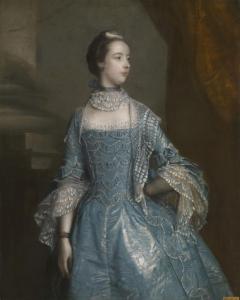 u can see how fine these new neck cloths are and just how see-through they are. Interestingly our friend E.Dixie here has it crossed over slightly – not so that it goes round the back but so that it lies nice and flat at the front. Her breast knot also seems to be attached on top of it and possibly acting like a pin.
u can see how fine these new neck cloths are and just how see-through they are. Interestingly our friend E.Dixie here has it crossed over slightly – not so that it goes round the back but so that it lies nice and flat at the front. Her breast knot also seems to be attached on top of it and possibly acting like a pin.
In the next image you can see the same fine cloth being worn but in a ‘A Loose Method’. It is a painting by Reynolds dated 1756 and is also a wonderful example of lace being worn round the neck as decoration. This is the beginnings of our modern day understanding of the term ‘necklace’ – isn’t it fascinating! The neck cloth also seems to develop a lot of embroidery or pleating detail running parallel with the hems at this time, but this could be purely due to the fact that we are suddenly seeing more of the cloth in the paintings or it could be attributed to the fact that the cloth had become finer so could take more bulky decoration such as pleating.
Now in the year 1757 – we have another painting by Devis and simply entitled ‘A Lady in Blue’. She may b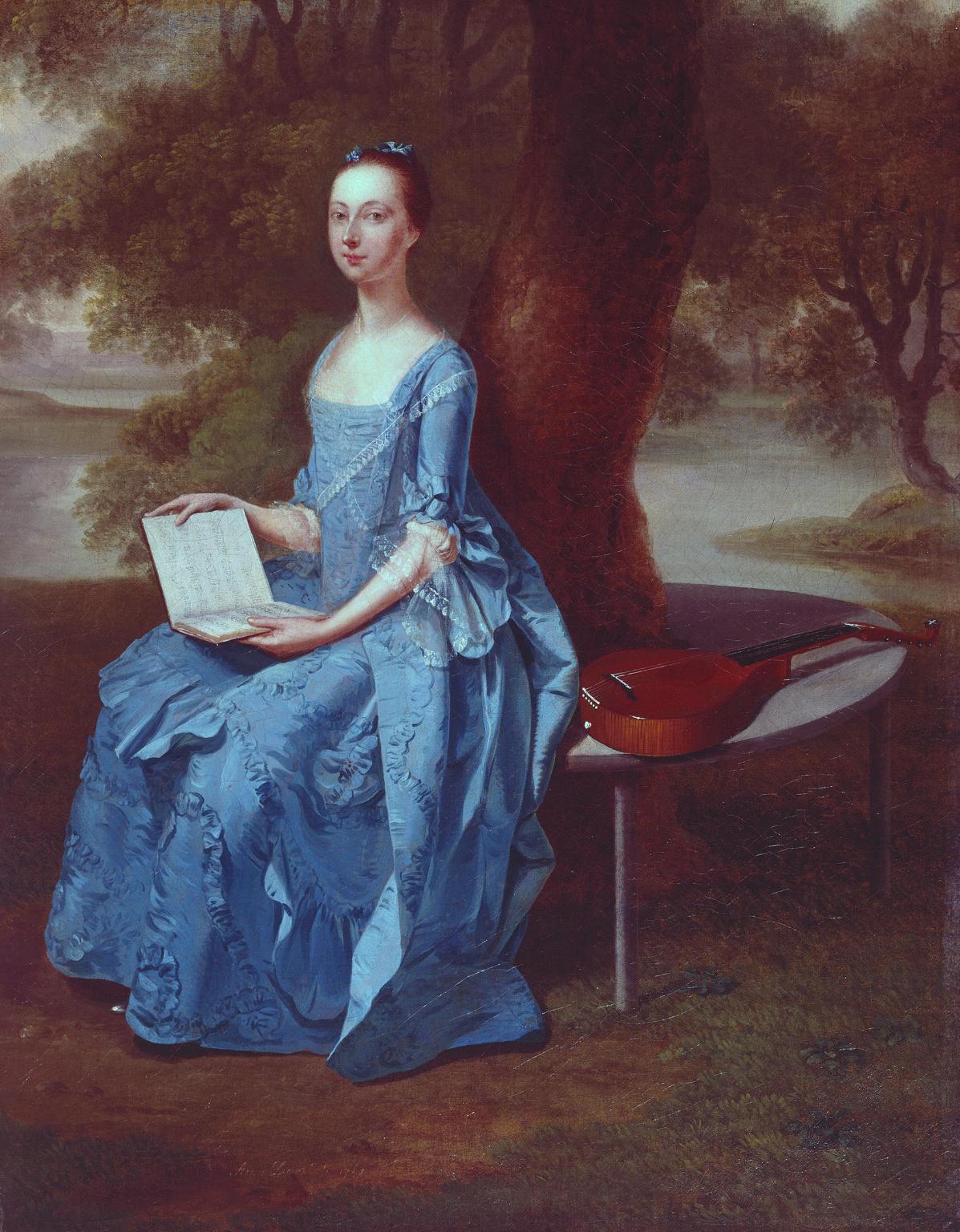 e simply a lady in blue but her dress is a stunning example of furbelow trimming – especially on the petticoat – just check this image out! We have a real appreciation for Arthur Devis here at HandBound costumes as, like with this painting, don’t you just feel you copy this dress straight off the painting – there is so much everyday detail in there. She also has an interesting thing on her head in the same blue. Her gown has narrow robings, and a very much exaggerated elongated body. This must have partly to do with the artists freedom – but this look, the lowered waist still hasn’t really changed much from the 1600s. It is virtually impossible (or atleast we have found it so, so far) to push the waist any lower in reality than about an inch. The stays permanently want to ride back up again to their comfortable waist position and you have the rather significant problem of their being bone in the way from the hip. We figure it is mostly to do with playing around with the dress rather than the Stays, for example, bring the skirts at the side up to just below the waist and still have the front point of the Stomacher very much lowered so that it gives an impression of a long waist. Can we just say here that this is only our surmising. Stays were certainly longer than one would expect for a group of people traditionally not reaching our massive heights of 5’10” and above, but the shoulder straps are short suggesting that the Stays, rather than being worn lower, actually rode rather high. It is rather hard to tell where the waistline is on a pair of Stays – and especially hard to say where that waistline was worn.This thing with the Stays coming quite far up into the scye, also matches paintings and sketches of women in stays. Leaving all of that behind, the last thing we need to say on our Lady of Blue, is rather pointedly, that she is wearing a super fine Neck cloth in a half ‘Crossed Over Method’ but without the tying at the back – this look much more ‘positioned’ than ‘pulled.’
e simply a lady in blue but her dress is a stunning example of furbelow trimming – especially on the petticoat – just check this image out! We have a real appreciation for Arthur Devis here at HandBound costumes as, like with this painting, don’t you just feel you copy this dress straight off the painting – there is so much everyday detail in there. She also has an interesting thing on her head in the same blue. Her gown has narrow robings, and a very much exaggerated elongated body. This must have partly to do with the artists freedom – but this look, the lowered waist still hasn’t really changed much from the 1600s. It is virtually impossible (or atleast we have found it so, so far) to push the waist any lower in reality than about an inch. The stays permanently want to ride back up again to their comfortable waist position and you have the rather significant problem of their being bone in the way from the hip. We figure it is mostly to do with playing around with the dress rather than the Stays, for example, bring the skirts at the side up to just below the waist and still have the front point of the Stomacher very much lowered so that it gives an impression of a long waist. Can we just say here that this is only our surmising. Stays were certainly longer than one would expect for a group of people traditionally not reaching our massive heights of 5’10” and above, but the shoulder straps are short suggesting that the Stays, rather than being worn lower, actually rode rather high. It is rather hard to tell where the waistline is on a pair of Stays – and especially hard to say where that waistline was worn.This thing with the Stays coming quite far up into the scye, also matches paintings and sketches of women in stays. Leaving all of that behind, the last thing we need to say on our Lady of Blue, is rather pointedly, that she is wearing a super fine Neck cloth in a half ‘Crossed Over Method’ but without the tying at the back – this look much more ‘positioned’ than ‘pulled.’
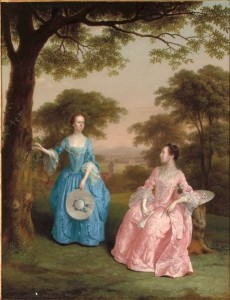
The next image, again showing ‘The Shoulder Method’ is from 1758 and is painted by Arthur Devis of Alicia and Jane Clarke. This fashion for such sheer cloths is obvious and sudden, and exciting to be able to plot so literally. You can just see under the pink lady’s armpit the edge of her super-fine neck cloth. Neither ladies have any way of fastening the cloth at the front.
As with today, not everyone is always struck with the same fashions and there are still images that run side by side this new Super-fine neck cloth. In these images they are still seem to be wearing the ‘Through the Lacing’ Method as before and the cloth seems less fine. The paintings: Mdm Jean-Louise Maisonnet and ‘The Family Group’ from the Tate (see above) are some examples of this – both being dated as mid 1750s;. There is also the L.Ebberton painting which we’ve already had a look at and given the vague date of 1750s. Why did we mention this? Because it is important to remember, it keeps our understanding balanced.
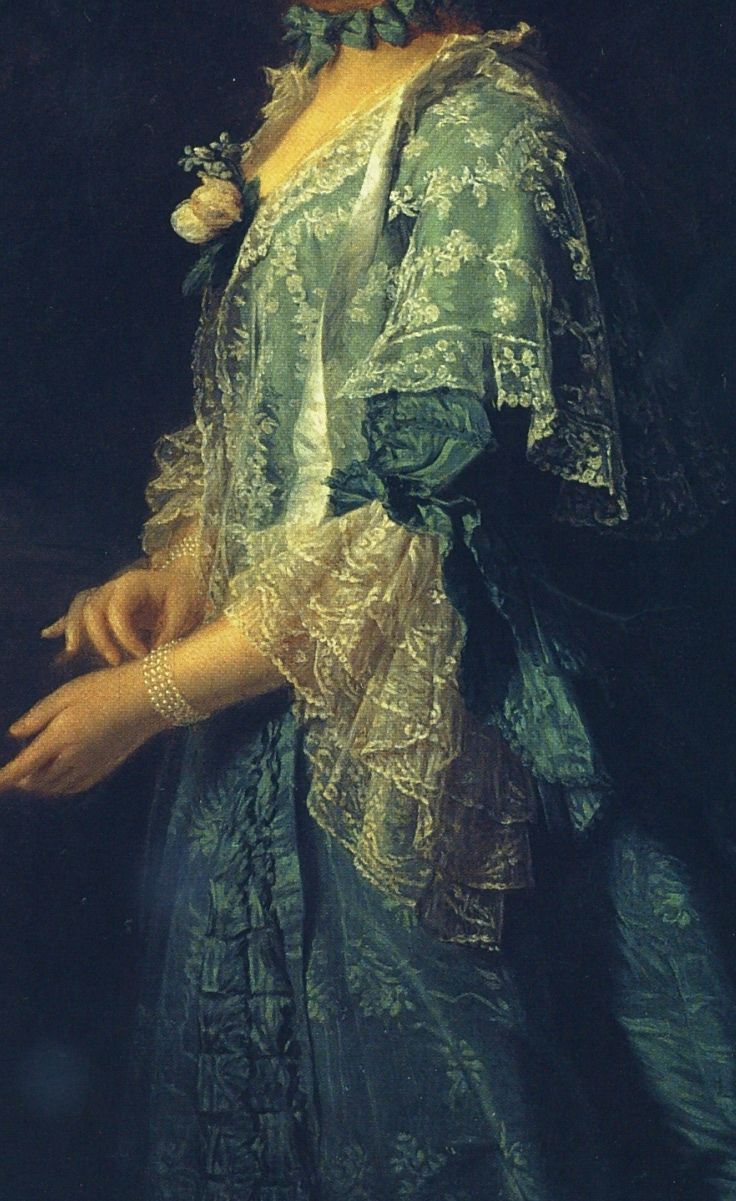 Moving on however, with more images of these fine cloths, we have the painting by Allan Ramsey (we’ve only got a detail of it here – isn’t it such beautiful work!) of Augusta of Saxe-Gothe, the Princess of Wales. Here she is wearing a fine neck cloth embroidered with white flowers and with what looks to be a bias/circular-cut frilled edging with a scalloped finish. It could be a lace sewn on but it seems to have a slight fluting to it which would match a bias or circular cut edging and the back ground of the trim looks to be the same as the rest of the cloth. The neck cloth also doesn’t appear to meet at the CF but drapes elegantly either side of the bosom garland. Interestingly enough hers looks to be almost like a fine cloth cape as there is a ribbon trailing delicately over it and some sort of thing at the neck – almost looking like a channel for the ribbon. This painting is dated 1759.
Moving on however, with more images of these fine cloths, we have the painting by Allan Ramsey (we’ve only got a detail of it here – isn’t it such beautiful work!) of Augusta of Saxe-Gothe, the Princess of Wales. Here she is wearing a fine neck cloth embroidered with white flowers and with what looks to be a bias/circular-cut frilled edging with a scalloped finish. It could be a lace sewn on but it seems to have a slight fluting to it which would match a bias or circular cut edging and the back ground of the trim looks to be the same as the rest of the cloth. The neck cloth also doesn’t appear to meet at the CF but drapes elegantly either side of the bosom garland. Interestingly enough hers looks to be almost like a fine cloth cape as there is a ribbon trailing delicately over it and some sort of thing at the neck – almost looking like a channel for the ribbon. This painting is dated 1759.
Just for other notes, she also wears a bosom flower (or garland) (Cunningtons), pearl bracelets, furbellow trim on her dress and 3 layers of lovely ruffles; lace or lawn we cannot tell.
What the Working Woman Wore:
Before we finish off this section, we just wanted to quickly list up what some of the more working class ladies were wearing – there is a few more variations to this group of ladies.
First up we have a woman from the market, sketched by Paul Sandby – c.1745. She is a fab woman – who we don’t think is wearing stays – her bust seems too curvacious but we may be wrong. Her hat is lined with what is normally silk so this clashes rather with the idea that she isn’t wearing stays. Her neck cloth is rather between styles. We’re opting for calling it ‘Through the Lacing’ – though it’s not through any lacing lol but it is positioned in the same place and being drawn over the CF opening of the gown.
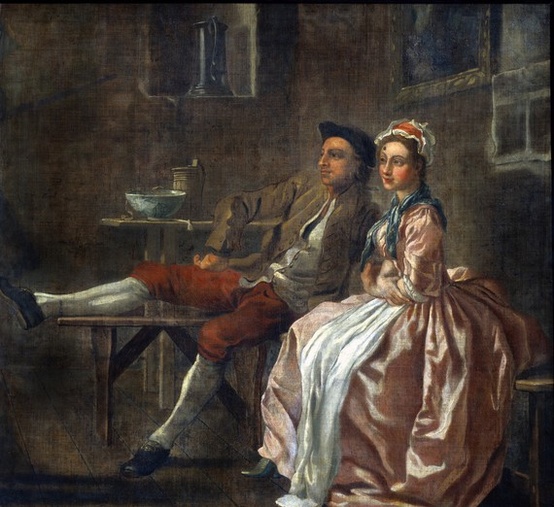 Next is an Oil painting called ‘The Wapping Landlady’. She here, wears a blue neck cloth in a ‘Tied Method’ . We can only think that tying or tucking must’ve been a much more reliable way to wear the Neck cloth without faffing about with it getting in the way all the time. The V&A dates this as mid 18th c and her dress certainly reflects 1740s fashions – and those the up-to-date. This lady here isn’t the cream of the crop so it’s not unreasonable that she might be wearing a slightly older fashion of costume if we are looking nearer the 1750s or 60s when this painting was painted. Why am I saying all of this – I don’t know, I think I’m rambling. He’s
Next is an Oil painting called ‘The Wapping Landlady’. She here, wears a blue neck cloth in a ‘Tied Method’ . We can only think that tying or tucking must’ve been a much more reliable way to wear the Neck cloth without faffing about with it getting in the way all the time. The V&A dates this as mid 18th c and her dress certainly reflects 1740s fashions – and those the up-to-date. This lady here isn’t the cream of the crop so it’s not unreasonable that she might be wearing a slightly older fashion of costume if we are looking nearer the 1750s or 60s when this painting was painted. Why am I saying all of this – I don’t know, I think I’m rambling. He’s 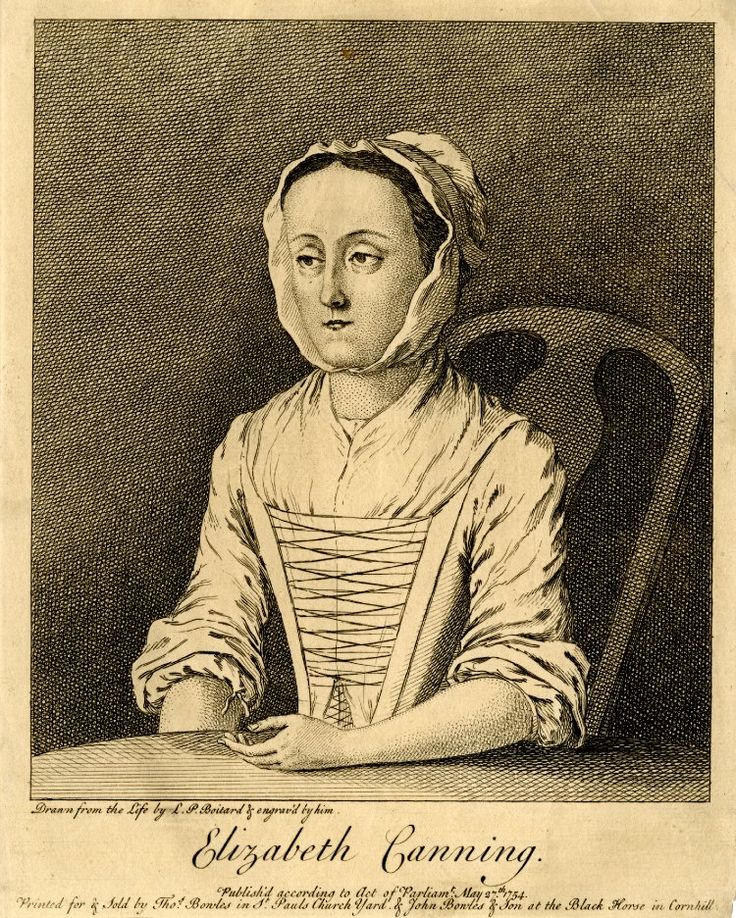 wearing his stockings under his breeches which is interesting – it’s during the 40s that this was becoming more and more fashionable but still George III wears his over his breeches in 1760.
wearing his stockings under his breeches which is interesting – it’s during the 40s that this was becoming more and more fashionable but still George III wears his over his breeches in 1760.
The next image has a fascinating story behind it – well worth a read on Wikipedia (Click here for the link to the page). The main reason we’re using this image on this page is obviously for her Neck cloth which is worn using a ‘Tucked In Method’ . The other interesting fact from this story is the price they set on the Stays that had been stolen – an amazing 10 shillings. She was working class, so that gives us a good estimation of what the working class would’ve expected to pay for a pair.





